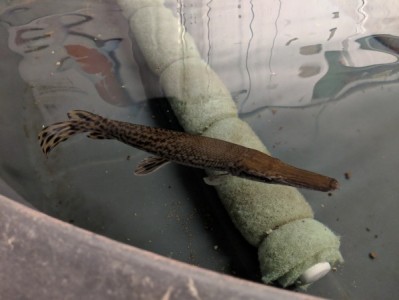- Name:
Spotted Gar
- Family: Lepisosteidae
- Species: Gar
- Scientific Name: Lepisosteus oculatus


More Details
General info about Spotted Gar
The Spotted Gar is a freshwater species that is native to North America. It has a long, slender body with a spotted pattern and can grow up to 3.5 feet (1.1 m) in length. It is a predatory species and requires a large aquarium with plenty of swimming space.
Spotted Gar Diet & Nutrition
The Spotted Gar is a carnivore and primarily feeds on small fish and invertebrates. It will also eat live or frozen foods such as shrimp, krill, or earthworms.
Determining Sex of Spotted Gar
Males tend to have a more slender and elongated body shape than females. During breeding season, males will develop a small bump on their head.
Breeding & Spawning Spotted Gar
Little is known about the breeding habits of Spotted Gars in the aquarium. In the wild, they are known to spawn during the spring.
Common Diseases with Spotted Gar
Spotted Gars are generally hardy and not susceptible to many diseases. However, poor water quality can lead to illness.
Spotted Gar Origin
The Spotted Gar is native to North America, from the Great Lakes to the Gulf of Mexico.
Caution with Spotted Gar
Spotted Gars are predatory species and should only be kept with other large, predatory fish. They should not be kept with small fish or invertebrates, as they will likely be eaten. They also require a large aquarium with plenty of swimming space.
Acclimating Spotted Gar
When introducing new Spotted Gars to the aquarium, it is important to acclimate them slowly to prevent shock. Float the bag in the aquarium for 15-20 minutes to allow the water temperature to equalize, then slowly add small amounts of aquarium water to the bag over the course of an hour.
Original Detail
| Name | Species | Family | Scientific Name | More Detail | Added by |
|---|---|---|---|---|---|
| Spotted Gar | Gar | Lepisosteidae | Lepisosteus oculatus | The Spotted Gar is a freshwater species that is native to North America. It has a long, slender body with a spotted pattern and can grow up to 3.5 feet (1.1 m) in length. It is a predatory species and requires a large aquarium with plenty of swimming space. | PalaciosAn |
Changed by users
| Submitted Date | Submitted By | Status | Action |
|---|

